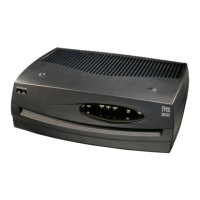Cisco Systems, Inc.
All contents are Copyright © 1992–2003 Cisco Systems, Inc. All rights reserved. Important Notices and Privacy Statement.
Page 12 of 19
Voice Implementation Requirements
The Cisco 1751 Modular Access Router supports FXO, FXS, E&M, ISDN BRI VICs, and T1/E1 multiflex V/WICs.
The FXO interface allows an analog connection to the central office of the Public Switched Telephone Network
(PSTN). The FXS interface connects basic telephone service phones (home phones), fax machines, key sets, and PBXs
through ring voltage and dial tone. The E&M interface allows connection for PBX trunk lines (tie lines). The
ISDN-BRI NT/TE VIC is used to connect to the PSTN or a PBX/KTS,whereas the T1/E1 multiflex V/WIC (multiflex
V/WIC) supports both data and voice services. The multiservice-ready Cisco 1751-V router version includes all the
features needed for immediate integration of data and voice services:
• One DSP—(PVDM-256K-4)
• 32-MB Flash memory
• 64-MB DRAM
• Cisco IOS IP/VOX Plus feature set
VICs and WICs are available separately.
The Cisco 1751 and Cisco 1751-V routers have two DSP module slots on the motherboard and a maximum of eight
DSPs are supported per router.
DSP Requirements
Cisco 1751 routers support 3 types of DSP images: high complexity (HC), medium complexity (MC) and Flexi-6.
HC and MC are used for analog
1
and BRI (VIC-2BRI-NT/TE) VICs; Flexi-6 is used for T1/E1 VWICs
2
and BRI VIC.
MC is introduced in Cisco 1751 starting from Cisco IOS 12.2(8)YN release, which will merge into 12.3(1)T.
Therefore, please make sure to use Cisco 12.2(8) YN or later releases when using MC. In addition, starting from
12.2(8)YN release, the default DSP image for BRI VIC is changed fromHC to Flexi-6.Table 7 lists the default images
for each type of VICs; Table 8 lists IOS support for each DSP image. Table 9 lists the number of channels supported
by one DSP (PVDM-256K-4) for each codec type.
Please use the following rules for calculating DSP requirements on the Cisco 1751:
1. For the Early Deployment (ED) releases: Cisco IOS 12.2(2)XK, 12.2(4)XW, 12.2(4)XL, 12.2(4)XM, 12.2(4)YA,
12.2(4)YB, 12.2(8)YL, 12.2(8)YM and 12.2(11)YT, or T train releases prior to 12.3(1)T:
VWIC-2MFT-E1-DI Two-port RJ-48 multiflex trunk - E1 with drop and insert
VWIC-1MFT-G703 One-port RJ-48 multiflex trunk - E1 G.703
VWIC-2MFT-G703 Two-port RJ-48 multiflex trunk - E1 G.703
1. The Cisco 1751 can support three VIC-4FXS/DID cards with a maximum of four ports in DID mode
1. Analog VICs includeVIC-2FXS, VIC-2FXO, VIC-2FXO-M1, VIC-2FXO-M2,VIC-2FXO-M3, VIC-2FXO-EU, VIC-2E/M, VIC-2DID,VIC-4FXS/
DID
2. T1/E1 VWICs include VWIC-1MFT-T1, VWIC-2MFT-T1, VWIC-2MFT-T1-DI, VWIC-1MFT-E1, VWIC-2MFT-E1, VWIC-2MFT-E1-DI,
VWIC-1MFT-G703, VWIC-2MFT-G703
Table 6 Voice Interface Cards for the Cisco 1751

